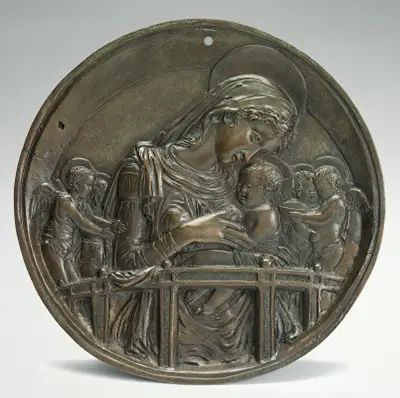Chellini Madonna (The Virgin and Child with Four Angels) is a bronze roundel that has a diameter of 28.5 centimetres, depth of 2.7 centimetres and weight of 4.26 kilograms.
Donatello, the Florentine artist, gave the roundel to Giovanni Chellini, who was his doctor, in 1456. The account book of that physician records this on 27 August 1456. It stated that Chellini treated Donatello and cured him of illness.
He continued saying that he's the singular and principal master when it comes to making figures made of bronze of wood plus terracotta. To show his gratitude of the medical treatment that Chellini provided him, Donatello gave him a roundel that was similar to a trencher in size. Donatello had sculpted on the roundel the Virgin Mary and a Child at her neck plus 2 angels on each side.
The roundel is one of Victoria and Albert Museum's most prized possessions. The daybook entry that was written by Dr Chellini makes the so-called Virgin and Child with Four Angels one of Donatello's most important works since very few can really be connected to such documentation.
The relief depicts the Virgin Mary embracing the Christ Child, who is tended by 4 angels. One of the angels reaches out to the Christ Child while another offers the Virgin a dish of sweetmeats or fruit. This displays a contemporary practice of offering gifts of food to a new mother.
Before the Renaissance, Virgin and Child relief carving in a roundel was very rare. However, by the 15th century, it had become a standard element that was used in wall monuments upper part. The roundel is unique like no other bronze, and it has a precise negative mould. The reverse of that roundel is hollowed out and creates a mould for casting the image replicas in a molten glass. Modern glass reliefs that were made from casts of this roundel's reverse have attested that claim. Most of the money that was needed to buy the relief was typically raised through a public appeal.
The circular design is corresponding to Renaissance architectural forms that are based on clear, geometric shapes. To emphasise architectural features in this roundel, instead of just treating the tondo shape as a frame, Donatello created the effect that people are capable of viewing the Virgin and Child with Four Angels through an aperture that's in a thick wall and also behind a railing, which adds a feeling of depth to the otherwise small and flat surface.
Also, the crescent shape of its reveal above plus the rising rail below defines a small stage for the scene, which establishes a low viewing point. That's a dramatic advance when compared to the previous Virgin and Child roundels, which were done on the same scale, where spatial depth wasn't accounted for.
The architectural composition quality was such that within several years (around 1457) he adapted it for a roundel in Siena Cathedral that was large, where the spectator saw it from below: it's evident that the illusion of viewing figures in a 'port-hole' is really convincing.
Chellini Madonna History
The Chellini Madonna probably arrived in England about 1748-1749, after Lord Malton bought the roundel from the descendants of Chellini, while he was on the Grand Tour. After that, the roundel passed through Earls Fitzwilliam successive ownership before being sold in the year 1954, when the authorship of the roundel had long been forgotten. In the year 1975, the roundel came to John Pope-Hennessy attention: he is the V&A (Victoria and Albert Museum) former director.
When he was leaving a dinner party that was held at the American Embassy, Pope-Hennessy ran into David Carritt, an art dealer, who told him he had found bronze relief that circular in shape from the 15th-century that people were using as an ashtray. Pope-Hennessy asked the art dealer if he could see the bronze relief; the following day, Carritt brought it to him.
Pope-Hennessy stated that its front face matched the other reliefs. However, what mattered most was the reverse of the roundel; when the former director of V&A turned it over, he found the mould that was described by Giovanni Chellini in is account book. The roundel was intended to be taken to the US; however, following a public appeal plus the limited edition silver casts sale from the reverse, the piece was secured in 1976 for the London Museum.
Also, the Victoria and Albert Museum is fortunate to possess Giovanni Chellini's marble bust (Museum number 7671-1861). It's signed by Antonio Rossellino, (1427 to 1479); an inscription is dating it to 1456, which is the same year as the gift Donatello gave Chellini.
Additionally, the V&A Museum in London also holds original sculptures, paintings and notebooks by other famous Italian artists such as Leonardo da Vinci, Giambologna, Gian Lorenzo Bernini, Andrea del Verrocchio, Giovanni Pisano (completed the first pair of doors prior to Lorenzo Ghiberti), Antonio Canova plus famous French sculptor, Auguste Rodin.
The Madonnas Made by Donatello
Throughout Donatello's career, he made Madonna and Child reliefs in bronze, terracotta and marble. The earliest of these Madonna and Child reliefs is the 'Pazzi Madonna', which can be found at Berlin Museums and dates from the 1420s. Then much later, is the gilded terracotta 'Madonna' at Victoria and Albert Museum: when it comes to its style, it is close to the Chellini bronze.
While Donatello was still in Padua between 1443 and 1453, at least 2 Madonna compositions were designed, but there are no originals that survived, plaster casts exist in the city of Verona. The last documented 'Madonna' by Donatello is the roundel in Siena Cathedral, which was carved largely by assistants.
What makes the Chellini bronze important is its artistic merits and the fact that it was produced before or in 1456, which is the date that Donatello gave it to Dr Chellini. There's indeed a reason to believe that the roundel may have been made several years earlier, the period when Donatello was still in Padua.




